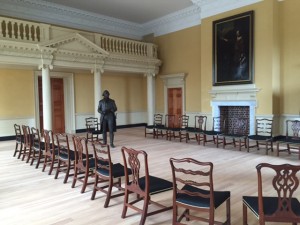Archives
Old Senate Chamber Restored to its Original Appearance

George Washington resigned his commission as commander-in-chief of the Continental Army before Congress in the Old Senate Chamber. His original resignation letter is on display directly outside the Chamber.
Its walls witnessed events that shaped our nation’s history, and after more than five years of intense physical and archival research, in-depth analyses and consultations, and true-to-history design and construction, the Old Senate Chamber in the Maryland State House was returned to its historic 1783 appearance this year. DGS oversaw the project with assistance from the Maryland Historical Trust and the Maryland State Archives.
The Old Senate Chamber was the site of events that influenced the course of our nation’s history. From November 1783 to August 1784, Annapolis served as the nation’s first peacetime capital. During that time, the Old Senate Chamber was the home of the Continental Congress. George Washington resigned his military commission as commander-in-chief of the Continental Army before Congress in the Old Senate Chamber on Dec. 23, 1783. This act established civilian authority over the military and thus laid the foundation for democracy in the United States.
“The peaceful surrender of military power to a civilian authority was a turning point in U.S. history and established a fundamental principle of American democracy,” said Senate President Thomas V. Mike Miller, Jr. “Its history reminds us of the responsibility we all share to vigorously uphold the vision of a civil society and a representative democracy that took root in the Chamber.”
The Treaty of Paris, signed between Great Britain and America to end the Revolutionary War, was ratified in the Chamber by Congress in January 1784. And in May of 1784, Thomas Jefferson was appointed by Congress to join Ben Franklin and John Adams in Paris as a minister to Europe.
“We, as Marylanders, take great pride in our stewardship of the State House, the oldest such building in continuous legislative use in the nation,” said Governor Larry Hogan. “This project preserves and solidifies the legacy of the State House in our nation’s history and will allow visitors to learn about the events that were vital to the birth of our nation.”
The design called for extensive use of historic materials installed by highly-specialized craftsmen skilled and experienced in traditional building construction to create an authentic restoration. This included use of gypsum and lime plaster, wrought nails fabricated by hand by a blacksmith employing traditional methods, period door hardware, reclaimed lumber, use of traditional joinery for wood elements and application of historic paint finishes.
The project also features modern day safety systems which have been carefully incorporated into the historic elements to conceal their existence while providing the benefits of modern technologies to protect the Chamber and its visitors; the most significant of these technologies are a mist fire suppression system and a smoke detection system, both of which have been seamlessly integrated into the project while maintaining the 18th century appearance of the room.
“If Washington were to walk into the Chamber today, he would recognize it,” said Mark Schneidman, architect and senior project manager for the restoration.

 1-888-373-7888
1-888-373-7888 233733
233733